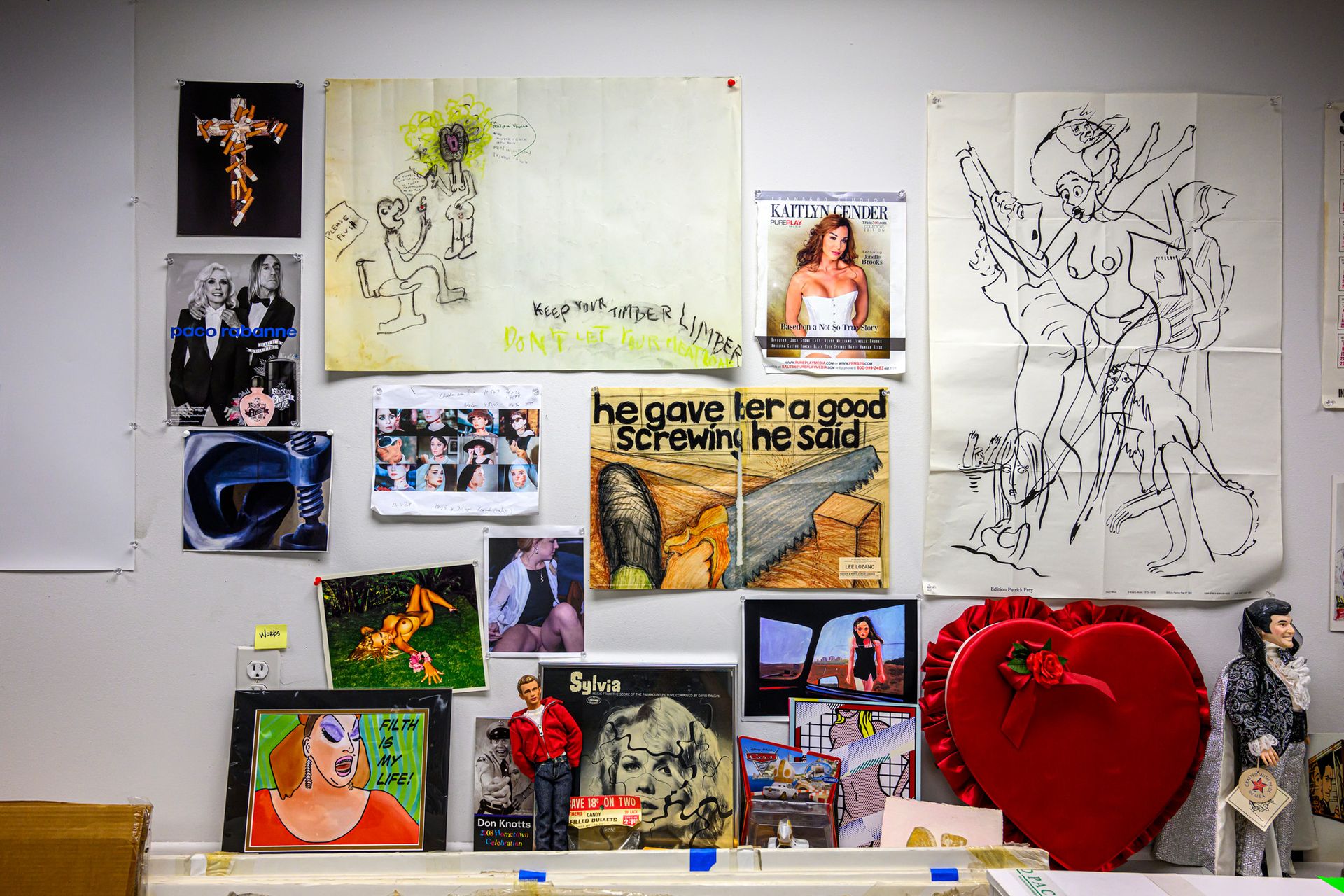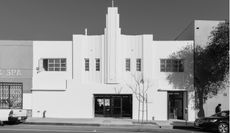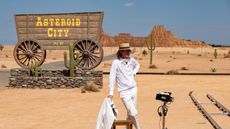John Waters on his weird and wonderful world, celebrated in new LA exhibition
The cult filmmaker invites us into his studio ahead of ‘John Waters: Pope of Trash’, at LA’s Academy Museum of Motion Pictures (from 17 September)

When LA’s Academy Museum of Motion Pictures opened in 2021, its most popular exhibit spotlighted the ruby slippers from The Wizard of Oz. It’s a shame they’re no longer on view because, in September 2023, John Waters (among our Wallpaper* USA 300) will follow an alternative yellow brick road to his own Emerald City – Hollywood – when the museum honours him with the first comprehensive exhibition of his artefacts, photographs, scrapbooks and movies.
‘John Waters: Pope of Trash’
Waters quips, ‘The Wizard of Oz is still my favourite movie, but I never understood why Dorothy wanted to go back home to that dreary farm when she had gay lions, winged monkeys and magic shoes.’
Since the 1960s, the Baltimore-born filmmaker has borrowed from the trashiest of B-movies, gore and sex-laden offerings by the likes of Herschell Gordon Lewis and Russ Meyer, while contributing his own low-brow humour, high-camp style and elements of fantasy. His early inspirations were basic. ‘I watched foreign movies because they broke all the censorship laws, and I watched exploitation movies. Baltimore was a treasure trove of exploitation distribution.’

Collected objects in Waters’ studio
From the underground success of Pink Flamingos (1972), starring the voluptuous and coprophiliac Divine (the pseudonym of his principal star Harris Glenn Milstead) to Hairspray (1988), which went on to become a Broadway musical, Waters has employed his black humour in outrageous and obnoxious stories, no matter what the budget.
This exhibition can be seen as a blue-chip endorsement of his achievements. ‘I’m incredibly proud, with no irony,’ he says. ‘It’s an example for every crazy kid. Basically, anything can happen.’ He is also getting his own star on the Hollywood Walk of Fame.
Academy Museum curator Jenny He explains that the show opens with an ‘abstracted church setting that winks at several aspects of John’s personal history and filmmaking’, while ‘an experiential dance gallery’ will highlight the importance of music in his films. Displays will be packed with his old cameras, memos, handwritten scripts, and props like the exploding wig worn by Debbie Harry in Hairspray and the tutu sported by Jean Hill in Desperate Living.

On the studio wall
‘This is an exciting moment to reflect on John’s career,’ says associate curator Dara Jaffe. ‘Many of the socio-economic themes from his films, like class, taste and propriety, have undergone significant social transformation over the last several decades. A striking example is Pink Flamingos, which faced bans in multiple countries and carried an X rating by the MPAA upon its release. In 2021, the Library of Congress inducted it into its National Film Registry.’
Waters still sports the pencil-thin moustache he adopted after first seeing it on Little Richard. His primary residence is in his native Baltimore, though he also has places in New York, San Francisco and Provincetown, where he has long summered. Baltimore, however, is the wellspring, where, in his early films, he drafted friends to be the cast. ‘We all hung around together, gay, straight, black, white, poor, because none of us could even make it in our own minorities. I tried to make a movie that would make us laugh, and I still do.’
Raised in an affluent family, Waters was educated at private Catholic schools. Puppets were his first theatre and he had a small stage and costume box at home. ‘I was a puppeteer for children’s parties from ages 11-14. I got $25 a show, which was a lot.’
His parents took him to see The Howdy Doody Show being filmed for television in New York. Seeing the small stage and the cameras, he recalls, ‘I was excited and I knew this is it. This is the world I’m gonna be in.’

Collected objects
In the 1960s, he enrolled at NYU, got thrown out, discovered the films of Andy Warhol and Jonas Mekas, and set out on the filmmaking path with the 8mm black-and-white Hag in a Black Leather Jacket. Waters’ parents grudgingly supported his aspirations, even loaning him $10,000 to make Pink Flamingos, provided he pay them back with interest, which he did. ‘I was driven to do this. There was no reason for me to go to school. I knew what I wanted to do,’ he says.
Indirectly, his background contributed. ‘I was raised with extreme good taste so I could make fun of those rules. I couldn’t have rebelled if I didn’t know the rules,’ he says. ‘To break the rules with style, you have to know the rules.’ Think of Kathleen Turner in Serial Mom, driven to murder after seeing someone wearing white shoes after Labor Day.
Despite the appalling behaviour of his characters, the audiences are generally on their sides. ‘The right people win morally in my movies with the values they set up,’ Waters explains. ‘My whole career was exaggerating things that people would use against you, turning it into style. Anger leads to rebellion, and rebellion is how you can embrace what people use against you and win with it. That has been the subject matter and the moral of every movie, every book, every show I’ve ever done.’
‘John Waters: Pope of Trash’ will be on show from 17 September 2023 – 4 August 2024 at the Academy Museum of Motion Pictures, Wilshire Boulevard, Los Angeles, academymuseum.org
Wallpaper* Newsletter
Receive our daily digest of inspiration, escapism and design stories from around the world direct to your inbox
-
 Gallery Fumi makes LA debut with works from Max Lamb, Jeremy Anderson and more
Gallery Fumi makes LA debut with works from Max Lamb, Jeremy Anderson and moreFumi LA is the London design gallery’s takeover of Sized Studio, marking its first major US show (until 9 March 2024)
By Tianna Williams Published
-
 Brazil’s Casa Subtração contrasts dramatic concrete brutalism with openness
Brazil’s Casa Subtração contrasts dramatic concrete brutalism with opennessCasa Subtração by FGMF is defined by brutalist concrete and sharp angles that contrast with the green Brazilian landscape
By Ellie Stathaki Published
-
 Level up at the The Residence, Claridge’s new André Fu-designed penthouse
Level up at the The Residence, Claridge’s new André Fu-designed penthouseClaridge’s The Residence is a new purpose-built two-tier glasshouse overlooking London’s skyline
By Lauren Ho Published
-
 Heads up for London Film Festival 2023’s immersive art programme
Heads up for London Film Festival 2023’s immersive art programmeFrom VR fungi to AR walks, London Film Festival 2023 announces LFF Expanded, a compelling programme of immersive art and extended realities
By Tianna Williams Published
-
 Asteroid City behind the scenes: How the world fell under Wes Anderson’s retro-tinted spell
Asteroid City behind the scenes: How the world fell under Wes Anderson’s retro-tinted spellWe peek behind the scenes of Wes Anderson’s new film Asteroid City, and explore how the world has gone barmy for the American filmmaker’s pastel-hued aesthetic
By Jessica Klingelfuss Last updated
-
 Steve McQueen to screen his harrowing film 'Grenfell' at London’s Serpentine
Steve McQueen to screen his harrowing film 'Grenfell' at London’s SerpentineAcclaimed film director and artist Steve McQueen will screen his film, Grenfell, at London’s Serpentine South gallery (7 April-10 May 2023), six years after the Grenfell Tower block blaze killed 72
By Harriet Lloyd-Smith Published
-
 Nan Goldin documentary is a gritty tale of addiction, resilience, and battles with the Sackler family
Nan Goldin documentary is a gritty tale of addiction, resilience, and battles with the Sackler familyAll the Beauty and the Bloodshed, directed by Laura Poitras chronicles acclaimed photographer Nan Goldin’s complex life, work, and tireless activism to hold power to account
By Harriet Lloyd-Smith Published
-
 Baz Luhrmann on creativity, that iconic scene in Romeo + Juliet, and collaborating with Bombay Sapphire
Baz Luhrmann on creativity, that iconic scene in Romeo + Juliet, and collaborating with Bombay SapphireWe speak to legendary film director and creative maestro Baz Luhrmann for the launch of ‘Saw This Made This’, his latest campaign with gin label Bombay Sapphire
By Jessica Klingelfuss Last updated
-
 Artist Julianknxx on poetry, dreams and Switzerland
Artist Julianknxx on poetry, dreams and SwitzerlandAhead of the New York showing of his major new film with Switzerland Tourism, we visit the studio of London-based poet and filmmaker Julianknxx
By Jessica Klingelfuss Last updated
-
 Huw Lemmey navigates sex, politics and espionage in new film
Huw Lemmey navigates sex, politics and espionage in new filmUngentle is a fictional journey through 20th-century Britain, exploring the relationship between espionage and male homosexuality. A collaboration between Huw Lemmey and Onyeka Igwe, the film is on view at London’s Studio Voltaire in September
By Davy Pittoors Last updated
-
 Fondazione In Between Art Film: a cinematic celebration of time-based media in Venice
Fondazione In Between Art Film: a cinematic celebration of time-based media in VeniceBeatrice Bulgari’s new foundation, championing time-based media, takes over a disused hospital with a surreal group exhibition during the Venice Biennale 2022
By Amah-Rose Abrams Last updated










